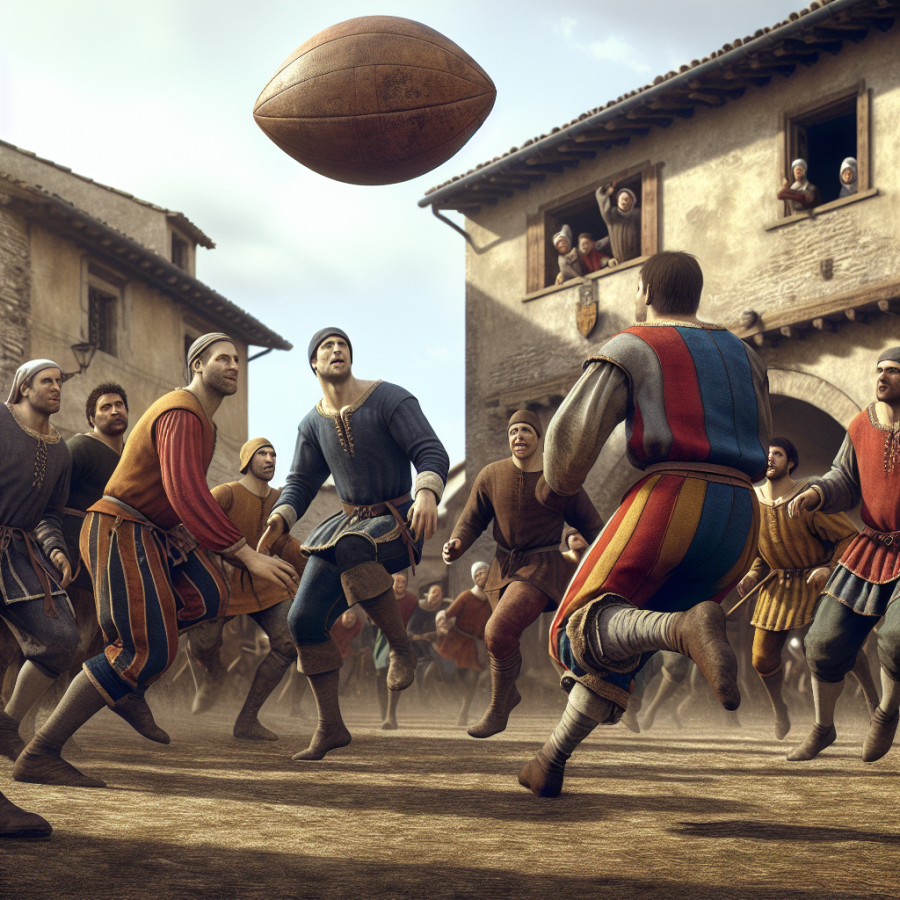From Mob Sport to Modern Magic: The Evolution of Medieval Football into Today's Game
Medieval football was a far cry from the well-regulated and orderly game we know today. This mob sport, often referred to as mob football, was more akin to a chaotic brawl than a structured sport. Generally played during festivals or important community events, these medieval matches resembled a pitched battle, involving entire villages or towns as players. The objective was simple—get the ball to a designated spot, which could be miles away, by any means necessary.
Rules were sparse and loosely interpreted, often leading to rounds of rough-and-tumble play with little regard for safety. Violence was a common feature, as the mass of players wrestled, kicked, and charged their way through the streets or across open fields. The ball, which could be a pig's bladder or a leather sphere, often became secondary to the brawl that ensued.
Despite the anarchy of its origins, or perhaps because of it, the game captured the hearts of its participants and spectators alike. Its unfettered nature made it a cathartic release for the pent-up aggression of daily feudal life. It was also an expression of community identity and pride, as neighboring villages competed against each other in a primal display of local patriotism.
As time wore on, football began to evolve. The chaotic elements were gradually tamed, especially as the game became favored by the upper classes. By the 19th century, public schools in England started creating their own versions of the game, with an emphasis on fostering teamwork and physical fitness rather than condoning full-scale brawls. Each school had its own set of rules, which would lead to the first steps towards codification.
The turning point for medieval football's transformation into modern soccer came in 1863 with the establishment of the Football Association in England. This body aimed to standardize the rules, drawing on those practiced by influential public schools and clubs. The result was the formal split between association football, or soccer, which strictly regulated the use of hands, and rugby football, where handling the ball was a defining feature.
Modern soccer owes its strategic depth and global appeal to this period of standardization. The chaos of the medieval game has been harnessed into a test of skill, strategy, and athletic prowess, drawing clear lines between permissible and foul play, often determined by the referee's whistle. The raw vigor of mob football is still present in today's matches but is expressed through coordinated team play, skillful footwork, and tactical brilliance.
Read also:
Puck Play: Unveiling Ice vs. Floor Hockey Distinction
Unraveling the Mayhem: The Roots and Rules of Medieval Football
Medieval football, often referred to as mob football, was a pastime that bore little resemblance to the highly regulated sport we know today. These games were community spectacles, encompassing entire villages and towns in chaotic clashes that honored tradition, celebrated holidays, and often settled old scores. The absence of standardized rules and the inclusion of limitless players turned these matches into sprawling, boisterous events that could consume the landscape for miles around.
The roots of medieval football can be traced back to various folk traditions. In England, France, and Scotland, among other parts of Europe, Shrove Tuesday was a common time for such matches, tying the game to the pre-Lenten festivities. However, the sport wasn't confined to a single social or religious occasion. It blossomed out of a natural human inclination for competitive play and community rivalry. These games were often played between neighboring towns and villages, with goals set miles apart.
Unlike the structured football of the modern era, medieval football had very few rules. The primary objective was to move a ball, which could be anything from an inflated pig's bladder to a simple leather sphere, from one designated spot to another. These points could be anything agreed upon before the game: markers, trees, or even the doorways of the opposing team's parish church. With matches taking place over fields, forests, and rivers, the terrain itself shaped the challenge at hand.
Physical prowess and aggression were central to the game, as there was no limit to the number of players, and nearly anything went in terms of tackling and ball movement. The ball could be kicked, thrown, or carried, leading to confused melees of players all vying for control. Businesses would close, and entire towns would empty as spectators and participants flocked to the game. Full-bore skirmishes would often erupt, and it was not uncommon for these matches to lead to injuries, and sometimes, even fatalities. Despite—or perhaps because of—the potential for violence, the games were incredibly popular and a point of communal pride.
Attempts were made over the centuries to either ban or refine these unruly spectacles. However, these games were resilient, etched so deeply into the cultural fabric that they often persisted. In some cases, the games served as a conduit for social order, allowing tensions to be released in a somewhat controlled environment.
As time passed, these lawless contests gradually faded, giving way to more organized and codified forms of football.




